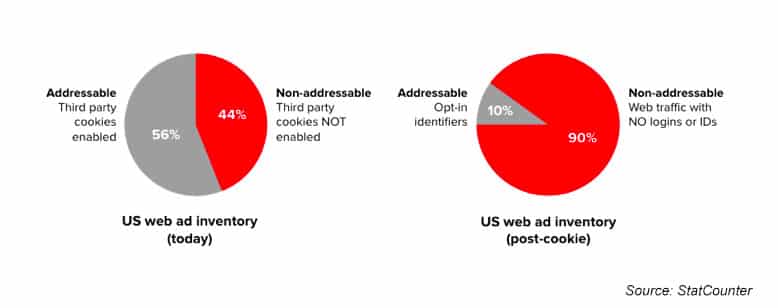Google’s Announcement Confirms Cookie Deprecation Is A Chance To Kick The Identifier Addiction, Not Replace It
There’s been a great deal of hand-wringing over the future of identity in digital advertising. Google Chrome’s plan to retire third-party cookies and Apple’s move to make IDFAs opt-in have kicked off what, to many, feels like a crisis for digital advertising.
Google’s recent announcement that it won’t provide alternate user-level identifiers is just the latest indication that we are well within an inexorable shift towards an opt-in world. This world is one where the only industry-accepted (and, in increasingly many jurisdictions, legally-accepted) means of addressable digital targeting is through an ID which the user has explicitly opted-in to using.
To be clear, there will be alternate user-level identifiers, just not built or used by Google. That horse race is well underway and will continue, unaffected by this news from Google. But new identifiers are not going to solve the ad world’s problems. Google’s announcement confirms that we won’t see one built into Chrome, and without the penetration provided by being default-on in a major browser, no new identifier will fill the hole left by cookies.
With the looming Chrome change in 2022, the frogs felt the water warming. Targeting remains possible, so there hasn’t been much urgency. But now that the identifiable internet is about to be reduced to a fraction of its size, the water is boiling. Advertisers need an escape, and switching to another identifier is the same as jumping to another pot. The only way off the hot stove is for advertisers to break free of identifiers as much as possible.
Insufficient replacements for third-party cookies
“Replacement” identifiers are jockeying for position, and are expected to provide precise targeting and granular measurement. The key improvement in these solutions is that the user consent is clear and explicit.
These replacement identifiers are built by companies other than the browser vendors and were never expected to be a Chrome-built browser feature, so to the extent that they are adopted by publishers and users, they will work regardless of whether Google buys into this philosophy.
Still, even before Google’s move this week, it would have been a mistake to think of these new opt-in identifiers as full replacement solutions. Any advertiser who plans on relying on these new identifiers to solve their problems needs to ask themselves, just how many of these impressions will be available? And am I willing to tie my campaign’s success to that number?
The availability, penetration, and number of impressions available with those solutions will depend on a number of factors, including publisher adoption and user behavior around opt-ins.
Certainly, the number of display impressions that can be targeted based on an addressable ID will be far less than today’s 56%. (Currently, about 44% of US internet users are already using web browsers without third-party cookies enabled.) The most ambitious estimates put the number of addressable impressions at around 30%, while many publishers believe 10% is optimistic. Whatever the end state, it will require a long adoption ramp-up, not a flip of a switch.
Think about that: Up to 90% of all display impressions will have no ID attached to them. Though the details remain uncertain, it’s clear that the replacement identifiers will not be enough. In order to effectively target at scale in the post-cookie world, advertisers need to adopt a portfolio of approaches that includes solutions to intelligently target ads where no identifiers are available.

Getting used to a non-identifiable world
The time to reach beyond addressable impressions is right now, before third-party cookies are retired from Chrome in 2022. Since 44% of US web impressions don’t have any IDs, smart, identifier-free targeting solutions could improve scaled performance immediately. Consider Safari users, who already exist outside the cookied universe. These consumers are on Apple products, which makes them highly-desirable, and it’s possible to reach them through a diversified approach.
Why is most of the industry still waiting to adopt identifier-free targeting solutions? The answer is measurement. It remains one of digital advertising’s key promises, which is why the industry has remained hooked on identifiers up to this point.
Google’s Chrome team has promised that a new measurement method will be in place before cookies are retired. But remember, Google can’t control what Apple, Mozilla, or others do with their browsers. After cookies are gone, targeting on the web without user IDs requires buying inventory that lacks a precise measurement mechanism.
But the other option, the choice most advertisers are already making, is sacrificing scale. Today, dedication to device-level measurement means ignoring more than 40% of online consumers on the web. In the very near future, they’ll have to decide whether they’d rather ignore 70-90% of online consumers, or have fuzzier measurement across 100% of potential customers.
A “fuzzier” measurement solution might mean extrapolating performance into the non-addressable web, or using a more traditional measurement framework like media mix modeling. Yes, this feels counter to everything we’ve gained in the last decade of hyper-granular data collection and analytics. But most brands will actually see a better ROI when they expand their views and target across the entire internet at its full scale. Even better, adopting an identifier-agnostic strategy now will leave advertisers well positioned to deal with the continued shift towards opt-in identification across all digital environments, not just the web.
While looking ahead is frightening, remember that we’re starting at a point where roughly half of the online audience can’t be identified, right now. Waiting around for new identifiers only limits advertisers even more.
The lost opportunities have already arrived, via browsers like Safari. Why are advertisers abandoning huge segments simply to maintain the status quo, and why continue doing so? The water is about to boil, and advertisers need to decide whether to stick around, jump to a new pot, or get off the stove altogether.
Still have questions? Watch our previously recorded webinar to learn steps you can take today to future-proof your digital campaigns.


